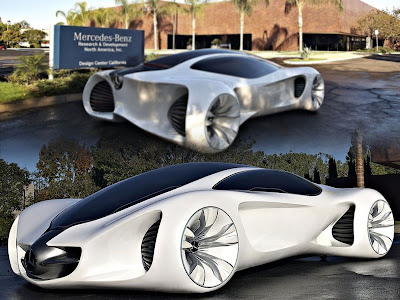2010 Mercedes-Benz Sport Cars Biome Concept
Born out of the 2010 LA Auto Show’s Los Angeles Design Challenge, in which automotive designers are given free range to envision the future of transportation, the Biome is meant to blend seamlessly into the planet’s ecosystem. That means all components of the 2010 Mercedes-Benz Sport Cars Biome Concept car are “grown” organically, and it emits pure oxygen and is fully compostable at the end of its service life.
2010 Mercedes-Benz Sport Cars Biome Concept
The basis for the Biome Concept is a vehicle that "grows in a completely organic environment from seeds sown in a nursery." Not only that, but it's powered by a combination of the sun and a chemical bond from an imaginary liquid dubbed BioNectar4534. It's all natural, all organic and all science fiction.
"As the inventor of the motor car, we wanted to illustrate the vision of the perfect vehicle of the future, which is created and functions in complete symbiosis with nature. The Mercedes-Benz BIOME is a natural technology hybrid, and forms part of our earth's ecosystem. It grows and thrives like the leaves on a tree" according to Hubert Lee, Head of the Mercedes-Benz Advanced Design Studios in Carlsbad.

2010 Mercedes-Benz Sport Cars Biome Concept
This year the competition had called for the creation of a vision of a safe and comfortable 2+2 compact car featuring good handling and a first-class design, and weighing only 1,000 lbs (around 454 kg/kerb weight).
The 2010 Mercedes-Benz Sport Cars Biome Concept symbiosis vehicle is made from an ultralight material called BioFibre and tips the scales at just 875.5 lbs (around 394 kg). This material is significantly lighter than metal or plastic, yet more robust than steel. BioFibre is grown from proprietary DNA in the Mercedes-Benz nursery, where it collects energy from the sun and stores it in a liquid chemical bond called BioNectar4534.

2010 Mercedes-Benz Sport Cars Biome Concept
The 2010 Mercedes-Benz Sport Cars Biome Concept is powered by BioNectar4534, which is stored in the BioFibre material of the chassis, interior, and wheels. In addition, Mercedes-Benz has developed a technology to equip trees with special receptors which can collect the excess solar energy and turn it into BioNectar4534. This creates a direct link with nature's energy sources and acts as an incentive to cover mobility energy requirements through more trees and at the same time maintain natural resources.
The Los Angeles Design Challenge is part of the Design Los Angeles conference, taking place from 17 to 18 November 2010 as part of the Los Angeles Auto Show.
 2010 Mercedes-Benz Sport Cars Biome Concept
2010 Mercedes-Benz Sport Cars Biome Concept
 2010 Mercedes-Benz Sport Cars Biome Concept
2010 Mercedes-Benz Sport Cars Biome Concept















 To compress the air needed for the centrally mounted air tank, Air Replenishment Sites are used. Powered by air turbines floating 1,000ft in the air they harness the power of the wind and convert it to electricity to provide the compression. The motors cool down with increased load, instead of heating up, which eliminates the need for cooling systems. The chassis, interior and suspension employ an integrated design which brings a notable contribution to the lowered weight.
To compress the air needed for the centrally mounted air tank, Air Replenishment Sites are used. Powered by air turbines floating 1,000ft in the air they harness the power of the wind and convert it to electricity to provide the compression. The motors cool down with increased load, instead of heating up, which eliminates the need for cooling systems. The chassis, interior and suspension employ an integrated design which brings a notable contribution to the lowered weight.


















 Rossin Bertin Vorax Sports Cars Concept
Rossin Bertin Vorax Sports Cars Concept





 Mob Toyota Sports Cars Concept
Mob Toyota Sports Cars Concept